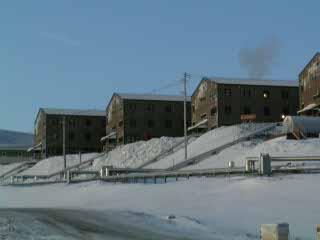24 August, 2003
South Celestial Pole
Today I spent most of my time in the Crary lab. I am learning the details and history of ozone depletion and this means a lot of reading. We did another session of ozone school and I learned about the distribution of ozone in the atmosphere. It is concentrated about 30km high in what is known as the Stratosphere. Ozone is three atoms of Oxygen bound together. I will explain more of this on a later date.
I did manage to get out this evening to take a picture of the south celestial pole. Most people know of the North Star or Polaris. By happenstance this star is directly above our north pole so as the earth spins under it it looks like it does not move. In the south however they are not so fortunate to have a star above the South Pole. So here you only see the rest of the stars rotate about an imaginary point in the sky. I left the camera shutter open for ten minutes under the sky. It was cold and foggy and lights from Mac town caused the picture to wash out, but if you look carefully you can see the stars are moving in a circle about the center. Four brighter stars near the bottom form the Southern Cross.
Our next balloon launch is a parcticle counter, however it may land over 100miles away which is further than the helicopters can go so we may postpone the launch until the winds are not as strong.

The stars appear to rotate about the south celestial pole as the earth spins.

The view to the South - South West. The Sea Ice is in the foreground.

The dorms where I am staying. They will be full in late October when the MainBody arrives.
Contact the TEA in the field at
.
If you cannot connect through your browser, copy the
TEA's e-mail address in the "To:" line of
your favorite e-mail package.
|
